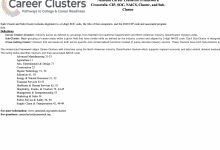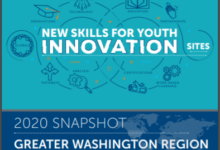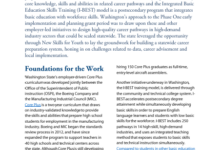Integrated Basic Education Skills Training, or I-BEST, is Washington State’s solution to the challenge of preparing basic skills learners to transition to college-level coursework. In 2005, when the program was first designed, state leaders at the State Board for Community and Technical Colleges (SBCTC) proposed an idea to improve credential attainment among adult learners. The program provides technical and basic skills instruction through an integrated curriculum and has demonstrated powerful outcomes, including a dramatic increase in credential attainment.
I-BEST is designed to support non-traditional postsecondary students, specifically those needing adult basic education or those for whom English is not their primary language. Participants are required to take a basic skills examination before they can enroll in the program. Once admitted, students pay tuition just as they would for any other community college course, though scholarship opportunities are available through the Opportunity Grant and other scholarship programs.
The program is structured so that students can build basic and technical skills simultaneously. The program is co-taught, with one instructor providing basic education — including reading, writing, digital literacy and employability skills — and the other providing more focused, technical instruction. All approved I-BEST programs must be aligned within a career pathway offered at the institution, ensuring participants can easily transition to further education and training once they complete the program. Classroom instructors have shared planning time to design their integrated curriculum and are required to co-teach in the classroom at least 50 percent of the time.
Colleges can submit applications for new I-BEST programs on an ongoing basis, but they must comply with SBCTC’s guidelines. The guidelines ensure that I-BEST programs are appropriately integrated and that learners receive not only joint instruction but integrated supports as well. Specifically, colleges implementing I-BEST programs must:
- incorporate rigorous college and career planning and other student services;
- ensure programs of study are designed with equal support from basic skills and Career Technical Education (CTE) administrators;
- provide joint instruction from basic skills and CTE instructors;
- jointly evaluate student and program success; and
- ensure classes are team taught with a minimum of 50 percent instructional overlap.
Additionally, co-taught I-BEST courses that meet SBCTC’s guidelines are eligible for enhanced funding (1.75 FTE, or full time enrollment, meaning the program gets 75 percent more funding for each enrolled student) to support the additional costs of administering the program. SBCTC regularly monitors the quality of participating programs to ensure they continue to meet learners’ needs.
Policy in Action
While I-BEST initially began as a promising strategy from a pilot initiative across ten colleges, it has since expanded across all 29 community colleges and five technical colleges in Washington State. As of fall 2019, 173 I-BEST programs were available in 14 career pathways, ranging from allied health to information technology to nursing.
In 2007, the Washington State legislature approved $11.5 million in annual funding for a tuition scholarship program called the Opportunity Grant Program that would help low-income adults prepare for high-wage careers. The program covers tuition and fees up to 45 credits, plus additional wrap-around services and up to $1,000 per academic year for books and supplies. To qualify, students must be residents of Washington State, have a family income at or below 200 percent of the federal poverty level, and be enrolled in a program of study leading to a high-wage career. While the Opportunity Grant is not exclusive to I-BEST, all approved programs meet the eligibility criteria and many I-BEST students rely on the grant to cover the cost of their tuition and fees.
Since its launch, I-BEST has become renowned nationwide as a model for basic education and skills training, in part due to a robust literature demonstrating positive outcomes for participating students. The Community College Research Center found that I-BEST students:
- were 23 percentage points more likely to earn college credit;
- were 17 percentage points more likely to persist in their program;
- were 40 percentage points more likely to earn a certificate or other award; and
- were 17 percentage points more likely to demonstrate improved basic skills.
Washington State’s I-BEST program was one of the earliest and most robust integrated education and skills training programs in the nation, but a number of states have begun to adopt similar programs of their own. According to a 2016 national policy scan by the National Skills Coalition, 18 states now have formal integrated education and training programs.
Related Links
- SBCTC Web Site: Integrated Basic Education Skills Training
- SBCTC Web Site: Opportunity Grant Program
- SBCTC Web Site: I-Best Program Fact Sheet (2018)
- I-BEST Expansion Application Guidelines (2016)
- CCRC Report: How I-BEST Works: Findings from a Field Study of Washington State’s Integrated Basic Education and Skills Training Program (2010)
- CCRC Brief: Building Bridges to Postsecondary Training for Low-Skill Adults: Outcomes of Washington State’s I-BEST Program (2009)
- National Skills Coalition: Integrated Education and Training Policy 50-State Scan (2016)
- U.S. Department of Health and Human Services: Washington State’s Integrated Basic Education and Skills Training (I-BEST) Program in Three Colleges: Implementation and Early Impact Report (2018)
Last updated October 2019




